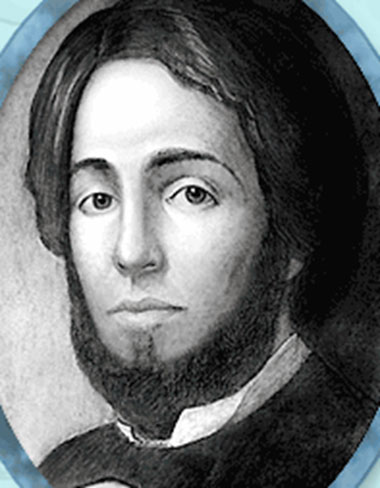Biographical Materials
The MEL Archive assembles a variety of materials that document Melville’s life, facilitating the study of Melville’s works within his life and times. Our Biography “to-do list” includes Gansevoort and Melville Family Trees, a Timeline of Melville family events, from Melville’s grandparents to his grandchildren, and a Melville Family Photo Album.
Currently, we have collected biographical materials that document interactions among Melville’s siblings, including his older brother Gansevoort and younger sister Augusta and Melville’s travels. Our proposed editions of his travel journals, letters, and Melville family correspondence contribute to biographical research.
The Melville Writing Coterie.
In 1845, Melville’s older brother Gansevoort made penciled corrections to Melville’s working draft of Typee. Family documents in NYPL’s Gansevoort-Lansing Family Collection also show that Gansevoort edited, and revised, his younger sister Augusta’s high school compositions; he probably revised Herman’s school work as well. As adolescents in the late 1830s, the three siblings and their sister Helen formed a kind of coterie, supporting each other in their learning to write. Gansevoort’s role as an editor is most evident in his revisions to Augusta’s 1836 term paper on the uses and abuses of power by famous men in history. For more on the Melville “Sibling Coterie,” see Part 3 of Herman Melville: A Half Known Life (Wiley-Blackwell), 2021.
Travel.
Melville traveled considerably, at home and abroad, from 1839 to 1860, and he used his travel experience in many of his books, both prose and poetry, from Typee and Omoo to Clarel and Timoleon. Melville alludes to places that he witnessed in person, some he never witnessed, and others he invented. In its long-standing commitment to examine Melville’s “geographical imagination,” MEL is building a database of images and texts related to travel.
Journals and Mapping.
Melville recorded his trips to England and Europe (1849), the Mediterranean and Middle East (1856-1857), and San Francisco (1860) in separate travel journals. For its edition of the journals, MEL uses TextLab to transcribe each leaf and FairCopy to annotate the texts.
MEL also uses Hofstra DRC’s mapping / timeline / annotation tool Itinerary to visualize Melville’s travels. The tool enables us to access place and time data drawn from Melville’s journals, to plot Melville’s daily touring on historical maps, to designate waypoints, to track plausible routes along city streets, and to annotate places with commentary, images, and journal texts (uploaded from TextLab). In the works are two Itinerary projects:
- Wyn Kelley’s “Melville in London,” which focuses on Melville’s 1849 tour of London, demonstrates the fullest use of Itinerary’s functionality.
- John Bryant’s “Melville in Rome,” the prototype for Itinerary, is a similar project focusing on Melville’s tour of Rome in 1857.
Melville Letters & Family Correspondence.
Melville’s letters to literary correspondents (such as Nathaniel Hawthorne and Evert Duyckinck) are well-known, readily accessible in print, and soon to be edited in MEL. Less known is the Melville family correspondence that records the daily life that surrounded the author. NYPL’s Gansevoort-Lansing Collection holds several boxes of family letters that were augmented in 1983 with the discovery of over 300 additional letters, known as the Augusta Papers. We will use MELCat, TextLab, and FairCopy to edit the texts of NYPL’s collection of Melville letters and family correspondence. With our editing of the correspondence, scholars will be able to situate Melville’s literary letters within the network of the family correspondence.
 View a larger version of the Young Melville picture.
View a larger version of the Young Melville picture.
Melville Family Writing Coterie
Gansevoort Revises Augusta: IntroductionMelville's Travel
Melville’s Travel: Using Itinerary Melville in London Melville in Rome Melville’s Geographical Imagination- Journals: Sample Images
- Letters & Family Correspondence: Sample Images
 Gansevoort Revises Augusta:
Introduction
Gansevoort Revises Augusta:
Introduction